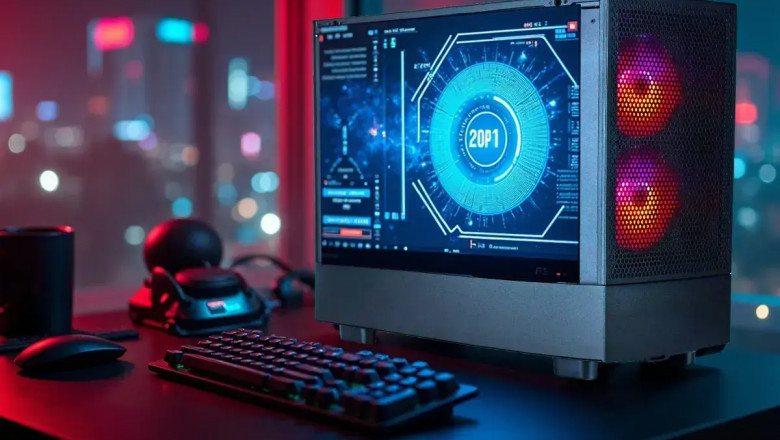views
Overclocking is the process of increasing the clock speed of a computer’s CPU, GPU, or RAM beyond the manufacturer’s default settings to achieve higher performance. Gamers, content creators, and power users often overclock their systems to enhance speed, responsiveness, and multitasking capabilities.
However, overclocking must be done carefully to avoid hardware damage, system instability, and reduced lifespan. Without proper cooling and monitoring, components can overheat, leading to crashes or even permanent failure.
In this guide, we will explore how to overclock your PC with safe overclocking techniques while maximizing performance and longevity.
Let’s get started!
Understanding Overclocking Basics
Overclocking applies to three primary components:
- CPU (Central Processing Unit): Adjusting the processor’s clock speed and voltage allows for faster execution of tasks.
- GPU (Graphics Processing Unit): Increasing the core and memory clock speeds enhances gaming and rendering performance.
- RAM (Random Access Memory): Faster memory speeds improve multitasking and data transfer rates.
Benefits of Overclocking
- Best overclocking practices can significantly improve system performance.
- For gamers, it means higher frame rates and smoother gameplay.
- Video editors and designers benefit from faster rendering times.
- Professionals who handle heavy applications experience improved responsiveness.
- It also helps extend the usability of older hardware by pushing it beyond its factory limits.
Risks Involved in Overclocking
While best overclocking practices can provide substantial benefits, it also carries risks. The most common issue is overheating, which can cause system instability, crashes, and long-term hardware degradation.
Excessive voltage can damage components, and improper overclocking may void warranties. Ensuring proper cooling and stress testing is essential to minimize these risks.
How to Overclock Your PC Safely?
Overclocking Your CPU
- The CPU is the most commonly overclocked component, and doing it safely requires adjustments in the BIOS.
- Restart your PC and enter the BIOS/UEFI by pressing DEL or F2 during boot.
- Locate the CPU multiplier setting and increase it gradually in small increments (e.g., 0.1 GHz at a time).
- Slightly raise the core voltage (Vcore) to maintain stability but avoid exceeding 1.35V for most processors.
- Run stability tests using Prime95 or AIDA64 to ensure the system can handle the new settings without crashing.
- If the system becomes unstable, reduce the clock speed or voltage and retest.
Overclocking Your GPU
- A safe GPU overclock improves gaming performance without overheating or causing crashes.
- Use overclocking software like MSI Afterburner or EVGA Precision X1 to adjust clock speeds.
- Increase the core clock speed in small increments (25-50 MHz per step) and test stability after each change.
- Adjust the memory clock slightly (50-100 MHz at a time) to improve performance.
- Run stress tests like Heaven Benchmark or FurMark to check for overheating or visual artifacts.
- Monitoring GPU temperatures is crucial, keeping them below 85°C ensures longevity.
Overclocking Your RAM
- Faster RAM speeds improve overall system performance, but incorrect settings can cause instability.
- In BIOS, enable Extreme Memory Profile (XMP) for automatic overclocking.
- For manual adjustments, reduce CAS latency and increase clock speed while keeping DRAM voltage below 1.4V for DDR4.
- Use MemTest86 to check for memory errors and ensure stability.
Ensuring Stability and Longevity
Overclocking is not just about pushing hardware limits; it’s also about maintaining long-term stability. Running extended stress tests is essential to detect potential instability. Tools like Prime95, FurMark, and MemTest86 help verify system stability.
Monitoring system temperatures is equally important; excessive heat shortens component lifespan. HWMonitor and HWiNFO are useful tools for tracking CPU, GPU, and RAM temperatures.
Proper cooling is another critical factor. Using an aftermarket air cooler or liquid cooling system prevents overheating. Case airflow should be optimized with well-placed intake and exhaust fans. Additionally, keeping voltage levels within manufacturer-recommended limits reduces the risk of hardware degradation over time.
Common Mistakes to Avoid
- Many users make critical errors when overclocking, leading to instability or hardware failure.
- One of the biggest mistakes is overvolting beyond safe limits
- Increasing voltage too much generates excessive heat, which can damage components
- Another common mistake is ignoring thermal limits. Poor cooling setups lead to overheating, which can cause the system to crash.
- Skipping stability tests is another dangerous oversight. Running an unstable overclock may lead to corrupted files, unexpected shutdowns, or system crashes.
- Finally, failing to have a recovery plan can be costly.
Users should always save BIOS settings before making changes and learn how to reset BIOS if the system becomes unbootable.
Final Thoughts
Overclocking can boost performance, but it must be done carefully to avoid overheating and instability. Gradual adjustments, proper cooling, and thorough stress testing are essential for a safe overclock.
Keeping voltages within safe limits and monitoring temperatures will help maintain system longevity. Avoid common mistakes like overvolting or skipping stability tests to prevent hardware damage. With the right approach, you can maximize your PC’s potential while ensuring long-term reliability.
Ready to Elevate Your Game?
Visit TechnoidGamingPC today and unlock peak performance with our prebuilt gaming PCs, packed with overclocking potential for next-level gameplay.
Don’t wait — gear up now with a machine built to dominate!
Frequently Asked Questions (FAQs)
1. Can overclocking permanently damage my PC?
Yes, if done improperly. Excessive voltage, inadequate cooling, and ignoring stability tests can lead to hardware failure. Safe overclocking with proper monitoring minimizes the risk.
2. How do I know if my overclock is stable?
Run stress tests like Prime95, FurMark, or MemTest86 for at least an hour. If your system does not crash or overheat, the overclock is likely stable.
3. Does overclocking void my warranty?
In most cases, manufacturers typically do not cover overclocking-related damage. However, some brands provide limited warranties for mild overclocking.














Comments
0 comment